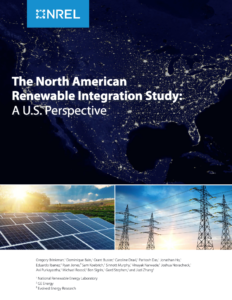Full Title: The North American Renewable Integration Study: A U.S. Perspective
Author(s): Gregory Brinkman, Dominique Bain, Grant Buster, Caroline Draxl, Paritosh Das, Jonathan Ho, Eduardo Ibanez, Ryan Jones, Sam Koebrich, Sinnott Murphy, Vinayak Narwade, Joshua Novacheck, Avi Purkayastha, Michael Rossol, Ben Sigrin, Gord Stephen, Jiazi Zhang
Publisher(s): National Renewable Energy Laboratory
Publication Date: August 17, 2021
Full Text: Download Resource
Description (excerpt):
The North American Renewable Integration Study (NARIS) is the first detailed power system integration study for the entire North American continent. NARIS aims to inform grid planners, operators, policymakers, and other stakeholders about the potential opportunities for system integration of large amounts of wind, solar, and hydropower to create a low-carbon grid in the future. The NARIS project began in 2016. This report describes a U.S. perspective in coordination with the U.S. Department of Energy, and a companion report describes a Canadian perspective in coordination with Natural Resources Canada.
The North American electric power grids are evolving toward higher contributions of variable generation (VG) resources (i.e., wind and solar) for several reasons, including lower costs and lower emissions. NARIS analyzes the entire North American continent, which is composed of five asynchronous interconnections that overlap the three countries. The analysis and conclusions of the study can help guide stakeholders to understand how the components of the power system can help work together to create a reliable, cost-effective, low-carbon grid in North America. This includes understanding the benefits of different technologies and operating practices to the future system.
The key analysis goals of NARIS were to evaluate a set of possible pathways for North American grid evolution through 2050 and to leverage production cost and Monte Carlo modeling tools to understand key questions about grid flexibility and resource adequacy.
